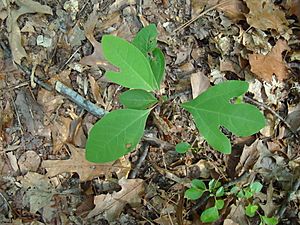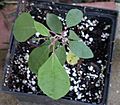White sassafras facts for kids
Quick facts for kids White sassafras |
|
|---|---|
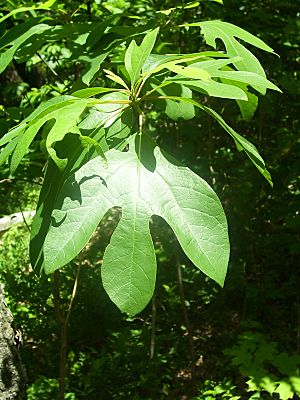 |
|
| Sassafras albidum, Wanaque, New Jersey | |
| Conservation status | |
| Scientific classification | |
| Genus: |
Sassafras
|
| Species: |
albidum
|
 |
|
| Natural range | |
| Synonyms | |
|
|
The Sassafras albidum tree is often called sassafras, white sassafras, red sassafras, or silky sassafras. It is a type of Sassafras tree that grows naturally in eastern North America. You can find it from southern Maine and Ontario all the way west to Iowa, and south to central Florida and eastern Texas. These trees usually grow in deciduous forests, which are forests where trees lose their leaves in the fall. They can grow at heights up to 1,500 meters (5,000 feet) above sea level. Sassafras trees used to grow in southern Wisconsin too, but they are no longer found there naturally.
Contents
About the Sassafras Tree
Sassafras albidum is a medium-sized deciduous tree. This means it loses its leaves every autumn. It can grow to be about 15 to 20 meters (50 to 65 feet) tall. Its branches can spread out up to 12 meters (40 feet) wide. The main trunk can be as thick as 60 centimeters (24 inches) across.
Bark and Branches
The bark on older sassafras trees is thick and dark reddish-brown. It has deep grooves, making it look rugged. When the tree is young, its new shoots are bright yellow-green. The bark on these young shoots feels a bit slimy, or mucilaginous. As they get older, the shoots turn reddish-brown. After a few years, small cracks start to appear in the bark.
Leaves
The leaves of the sassafras tree are very interesting. They grow one after another along the branch, not in pairs. They are green to yellow-green and shaped like an oval or wider at the top. Each leaf is about 10 to 15 centimeters (4 to 6 inches) long and 5 to 10 centimeters (2 to 4 inches) wide. They have a short, thin stem called a petiole.
What makes sassafras leaves special is that they come in three different shapes. You can often find all three shapes on the same branch!
- Some leaves are unlobed, meaning they are just a simple oval shape.
- Others have two lobes, looking a bit like a mitten.
- Many leaves have three lobes, like a trident.
Very rarely, you might even see leaves with more than three lobes. In the fall, these leaves turn beautiful shades of yellow, sometimes with hints of red.
Flowers and Fruit
In early spring, before the leaves fully appear, sassafras trees produce small flowers. These flowers grow in loose clusters that hang down. They are yellow to greenish-yellow and are about 5 centimeters (2 inches) long.
Most sassafras trees are dioecious. This means that male flowers and female flowers grow on separate trees. Male flowers have parts that produce pollen, while female flowers have parts that will become fruit. Insects help to carry pollen from male trees to female trees.
The fruit of the sassafras tree is a dark blue-black berry, about 1 centimeter (0.4 inches) long. It contains a single seed inside. The fruit grows on a red, club-shaped stem about 2 centimeters (0.8 inches) long. These fruits ripen in late summer. Birds eat the fruit and help spread the seeds. All parts of the sassafras plant have a pleasant, spicy smell.
Roots
The roots of the sassafras tree are thick and fleshy. They often send up new shoots from underground. These new shoots can grow into new trees, forming a group of trees that are all connected to the original one.
Where Sassafras Trees Grow
Sassafras trees like rich, sandy soil that drains water well. They prefer soil with a pH level between 6 and 7, which is slightly acidic to neutral. However, they can grow in any loose, moist soil.
Young sassafras seedlings can grow in shady spots. But as they get bigger, they need lots of sunlight to grow well. In forests, you'll often find new sassafras trees growing in open areas where old trees have fallen. Sassafras trees grow quickly, especially the new shoots that come from the roots. These root sprouts can grow 1.2 meters (4 feet) in their first year and up to 4.5 meters (15 feet) in just four years! Because of these root sprouts, a single sassafras tree can quickly create a dense group of new trees around it.
Sassafras trees are also important for some insects. For example, the caterpillars of the promethea silkmoth (Callosamia promethea) eat the leaves of the sassafras tree.
Laurel Wilt Disease
Sassafras trees can get a disease called laurel wilt. This disease starts when a tiny beetle, called the redbay ambrosia beetle, brings a harmful fungus into the tree's wood. The fungus then spreads and can make the tree sick. Sassafras trees can get this disease, and the beetles can even lay their eggs in sassafras trees. Scientists are studying how this disease spreads and if it might move to colder areas where sassafras trees are common. This beetle and fungus are originally from Asia and have been spreading through parts of the United States.
How People Use Sassafras
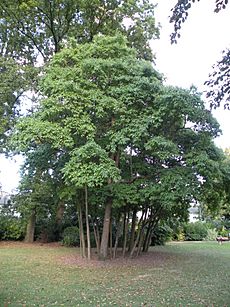
People have used almost every part of the sassafras tree for different purposes. This includes the stems, leaves, bark, wood, roots, fruit, and flowers. The sassafras tree is important in the history of both Europe and North America. It has been used for cooking and medicine for a very long time.
Native American Uses
Before Europeans arrived, many Native American tribes in the southeastern United States used sassafras. The Choctaw people called it "Kvfi." In Delaware and Virginia, it was known as "Winauk," and the Timuca people called it "Pauane."
Some Native American tribes used sassafras leaves to help heal wounds by rubbing them directly on the injury. They also used different parts of the plant for many health reasons, such as helping with skin problems, bladder issues, and fevers. The bark was also used to make dyes and to add flavor to food.
Native Americans also used sassafras wood to start fires. This is because the wood contains natural oils that catch fire easily.
In cooking, some Native Americans used sassafras to flavor bear fat and to preserve meats. Even today, sassafras is still used to cure meats. The Choctaw people used a spice called filé powder, made from sassafras leaves, in their cooking. This use helped create gumbo, a famous dish from Louisiana.
Modern Culinary Uses
In the United States, sassafras is mainly used in two ways:
- It's a key ingredient in homemade root beer.
- It's used as a thickener and flavor in traditional Louisiana Creole gumbo.
Filé powder, also known as gumbo filé, is a spicy herb made from the dried and ground leaves of the sassafras tree. Native Americans in the Southern United States traditionally used it. Later, it became a part of Louisiana Creole cooking. The leaves and root bark can be crushed to flavor soups, gravies, and meats.
While sassafras roots are used to make traditional root beer, the U.S. Food and Drug Administration (FDA) banned them for use in mass-produced foods and medicines in 1960. This was because of a natural oil found in sassafras called safrole.
Safrole Oil and Other Uses
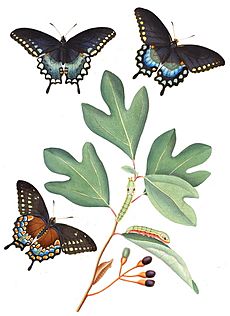
Safrole is an oil that can be taken from the root bark of the sassafras tree. It has been used as a natural way to keep insects or pests away. Sassafras was also used to add flavor and cover up strong smells in some old-fashioned medicines.
Today, most commercial "sassafras oil" that contains safrole comes from other trees in Asia or Brazil.
The wood of the sassafras tree is a dull orange-brown color. It is hard and lasts a long time, even when it's in contact with the soil. In the past, people used sassafras wood for fence posts, rails, small boats, and parts of ox-yokes. Because it's harder to find large sassafras trees now, it's not used as much for these things. However, some sassafras wood is still used to make furniture.
History of Sassafras Trade
Europeans first learned about sassafras, along with other plants like cranberries and tobacco, when they arrived in North America.
Early European settlers described the pleasant smell of sassafras trees. There's even a story that Christopher Columbus knew he was close to North America because he could smell the sassafras. As early as the 1560s, French visitors found out about the health benefits of sassafras. English settlers at Roanoke even said they survived by eating boiled sassafras leaves during tough times.
When the English arrived on the East Coast of North America, they found many sassafras trees. Sassafras was sold in England and other parts of Europe as a dark drink called "saloop." This drink was believed to have medicinal qualities and was used to treat various illnesses, including fevers.
Sir Francis Drake was one of the first to bring sassafras to England in 1586. Sir Walter Raleigh was the first to export sassafras as a product in 1602. Sassafras quickly became a major export from North America to Europe. It was valued for its medicinal roots and its beautiful, strong wood. The search for sassafras even led Captain Martin Pring to explore the coasts of present-day Maine, New Hampshire, and Massachusetts in 1603. For a short time in the early 1600s, sassafras was the second-biggest export from the British colonies in North America, right after tobacco.
The bark of the sassafras tree was the most valuable part because it contained a lot of the aromatic safrole oil. This meant that once the bark was gathered from a tree, it couldn't be harvested again for a long time. As a result, supplies of sassafras quickly became scarce. For example, in 1602, one shipment of sassafras weighed a ton. But by 1626, English colonists couldn't even meet a much smaller goal of 30 pounds. The demand for sassafras was so high in England that its import was even mentioned in the official document for the Colony of Virginia in 1610.
Today, sassafras plants are still harvested for safrole oil. However, sassafras plants from China and Brazil are more commonly used for this purpose than the North American Sassafras albidum.
Images for kids
See also
 In Spanish: Sassafras albidum para niños
In Spanish: Sassafras albidum para niños



